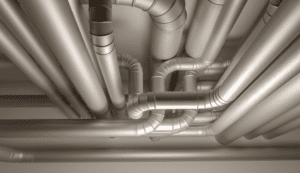Every heating and cooling system in existence works on the fundamental laws of thermodynamics. Fortunately, due to centuries of applied science, we have a thorough understanding of these laws and how to apply them to home heating and cooling. To better appreciate the science on which we rely, we must ask: what is thermodynamics?
Thermodynamics is a branch within physics that focuses on understanding the way that energy moves within a system. You can apply the lessons learned from it to other areas of science and how the universe works, as energy is an integral part of any activity. We will first look at the history of thermodynamics and when we began to study it in depth, then review the three laws of thermodynamics, and finally, determine how all theory applies to the real world.
What Is Thermodynamics’ History and Development?
 No single person is responsible for our understanding of thermodynamics today. Instead, it took centuries of study and experimentation to learn the foundational laws and understand how they apply. Natural scientists in Europe expressed curiosity over certain phenomena during the 17th century. However, it wasn’t until the invention of the steam engine in the 18th century that thermodynamics received dedicated attention as a scientific discipline.
No single person is responsible for our understanding of thermodynamics today. Instead, it took centuries of study and experimentation to learn the foundational laws and understand how they apply. Natural scientists in Europe expressed curiosity over certain phenomena during the 17th century. However, it wasn’t until the invention of the steam engine in the 18th century that thermodynamics received dedicated attention as a scientific discipline.
Those with scientific aptitude saw the potential for the steam engine to change the way that people traveled and worked significantly. It all came to fruition in the 19th century as railroads became widespread, along with the development of steamboats and powered machinery. By the mid-19th century, scientists had discovered the primary laws and applied their associated theories in other branches of physics. By the 20th century, the study became more esoteric as scientists such as Stephen Hawking applied the rules to black holes and pushed the boundary as to what is thermodynamics.
The Three Laws of Thermodynamics
The first three laws of thermodynamics were discovered and understood gradually. Each touch of a different concept, but together they form the basis of our understanding of how temperature works.
- The first law: The internal energy of an isolated system is constant.
Put into layman’s terms, this law says that energy can neither be created nor destroyed. It can move around from place to place, as with heat from your furnace to your living room. It can change forms, as with the potential energy in natural gas becoming heat in the furnace. It can also leave an open system, as with what happens when you open the front door during winter and the hot air escapes. Ultimately, the only truly closed system is the universe itself, though some speculate that even that is not closed. - The second law: Heat cannot spontaneously flow from a colder location to a hotter location.
This law often gets interchanged with the notion of entropy or disorder. Technically, entropy is the measure of heat or energy dispersal in a system. The second law tells us that, without effort, heat will always move from a warmer location to a cooler one, which is why the air rushes inside on a hot day if you have the air conditioner on. However, using technologies such as heat pumps, we can remove heat from a relatively colder location and bring it to a warmer one using electricity. - The third law: As a system approaches absolute zero, all processes cease, and the entropy of the system approaches a minimum value.
The third law provides the “stopping point” for entropy, but also indicates that in a finite amount of time, a system won’t actually reach absolute zero, -273°C. While this has significant mechanical implications at a highly technical level, it’s not as relevant for determining things such as building load or how to save on your power bill.
There is a fourth law, referred to as the “zeroth law” because it is more fundamental than the others. The operation of the others implied its existence, and today mostly has an impact by confirming that temperature is measurable as a separate thing from barometric pressure and humidity. Every time you adjust the thermostat on your HVAC system, you’re relying on our understanding of the zeroth law of thermodynamics.
HVAC Systems and the Real-Life Application of Thermodynamics
As the examples above show, thermodynamics are closely associated with the function of heating and cooling systems. With a proper understanding of what is thermodynamics, the laws involved, and where it came from, you can gain a new respect for the science behind the machines that keep you warm in the winter and cool in the summer. We have only scratched the surface of the subject, so if you find it interesting, there is much more to be learned.

